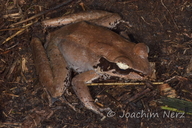|
Papurana grisea (Van Kampen, 1913)
| family: Ranidae genus: Papurana |
 © 2016 Dr. Joachim Nerz (1 of 8) |
|
|
|
Description Distribution and Habitat Country distribution from AmphibiaWeb's database: Indonesia, Papua New Guinea
Life History, Abundance, Activity, and Special Behaviors Call: Males sometimes call in the day during dull weather or at night and like to hide in clumps of sedge, occasionally exposing themselves. They make short series of 3-4 squeaks at long intervals (Menzies 1975). Each note lasts about 0.1 s and has an initial rise in frequency through 500 Hz and a rapid decline through 1 kHz. The frequency range is about 2-3 kHz (Menzies 1987).
References
Menzies, J. I. (1975). Handbook of Common New Guinea Frogs. Wau Ecology Institute, Papua New Guinea. Menzies, J. I. (1987). ''A taxonomic revision of Papuan Rana (Amphibia: Ranidae).'' Australian Journal of Zoology, 35, 373-418. Zweifel, R. G. (1980). ''Results of the Archbold Expeditions 103. Frogs and lizards from the Huon Peninsula, Papua New-Guinea.'' Bulletin of the American Museum of Natural History, 165, 390-434. Originally submitted by: Chih Wang (first posted 2003-05-13) Edited by: Tate Tunstall (2003-05-14) Species Account Citation: AmphibiaWeb 2003 Papurana grisea <https://amphibiaweb.org/species/5045> University of California, Berkeley, CA, USA. Accessed Apr 17, 2024.
Feedback or comments about this page.
Citation: AmphibiaWeb. 2024. <https://amphibiaweb.org> University of California, Berkeley, CA, USA. Accessed 17 Apr 2024. AmphibiaWeb's policy on data use. |




 Map of Life
Map of Life